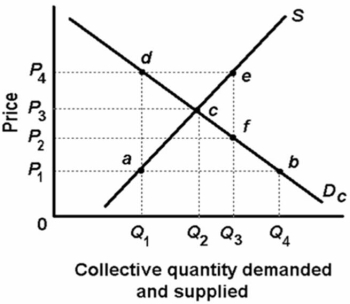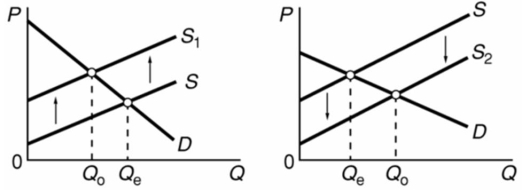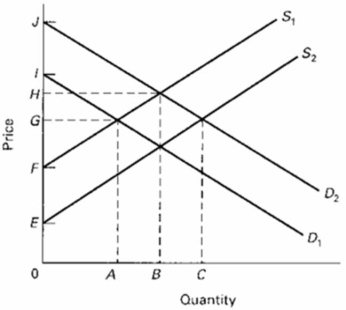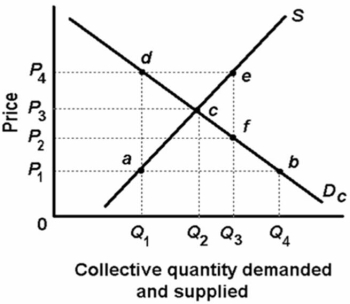A) conservation of matter and energy.
B) diminishing returns.
C) diminishing marginal utility.
D) increasing cost.
F) A) and C)
Correct Answer

verified
Correct Answer
verified
True/False
A supply-side market failure occurs when supply curves do not reflect the full cost of producing a good or service.
B) False
Correct Answer

verified
Correct Answer
verified
Multiple Choice
If some activity creates external benefits as well as private benefits, then economic theory suggests that the activity ought to be:
A) taxed.
B) prohibited.
C) subsidized.
D) left alone.
F) A) and B)
Correct Answer

verified
Correct Answer
verified
Multiple Choice
Refer to the supply and demand graph for a public good.Point c on the graph shows where the: 
A) total benefit equals the total cost of the public good.
B) marginal benefit equals the marginal cost of the public good.
C) average benefit equals the average cost of the public good.
D) total benefit equals the marginal cost of the public good.
F) A) and D)
Correct Answer

verified
Correct Answer
verified
Multiple Choice
If the price of a product increases:
A) the consumer surplus will decrease.
B) the consumer surplus will increase.
C) total revenue will increase if demand is price elastic.
D) total revenue will decrease if demand is price inelastic.
F) All of the above
Correct Answer

verified
Correct Answer
verified
Multiple Choice
Which of these is an example of an external cost?
A) an increase in the value of land you own when a nearby development is completed.
B) the costs paid by a company to build an automated factory.
C) decreased property values in a neighbourhood where several houses are burglarized.
D) the higher price you pay when you buy a heavily advertised product.
F) B) and C)
Correct Answer

verified
Correct Answer
verified
Multiple Choice
If there are external benefits or positive externalities associated with consumption and production of a product, it can be said that the:
A) government should consider placing a special tax on producers.
B) government should consider prohibiting the production of the commodity.
C) supply curve for the product lies too far to the right to provide an efficient allocation of resources.
D) demand curve understates the total benefit from the product and resources are under-allocated to its production.
F) None of the above
Correct Answer

verified
Correct Answer
verified
Multiple Choice
The graphs below refer to two separate product markets.Assume that society's optimal level of output in each market is Q0 and that government purposely shifts the market supply curve from S to S1 in diagram (a) and from S to S2 in diagram (b) .The shift of the supply curve from S to S2 in diagram (b) might be caused by a per unit: 
A) subsidy paid to the producers of this product.
B) tax on the producers of this product.
C) subsidy paid to the buyers of this product.
D) tax on the buyers of this product.
F) A) and B)
Correct Answer

verified
Correct Answer
verified
Multiple Choice
Refer to the below supply and demand graph.Point A represents the current equilibrium level of output of this product and point B represents the optimal level of output from society's perspective.This supply and demand graph indicates that there is (are) : 
A) positive externalities to the production of this product.
B) negative externalities to the production of this product.
C) an overallocation of resources to the production of this product.
D) a negative externality from the production of this product.
F) A) and C)
Correct Answer

verified
Correct Answer
verified
Multiple Choice
The term "Efficiency losses" refers to:
A) the producer loss due to the high cost of production.
B) the reductions of combined consumer and producer surplus associated with underproduction or overproduction of a product.
C) the consumer surplus minus the producer surplus.
D) the sum of consumer and producer surplus.
F) B) and C)
Correct Answer

verified
Correct Answer
verified
Multiple Choice
Which of the following methods is used to correct both negative and positive externalities?
A) Private bargaining
B) Tax on producers
C) Subsidy to consumers
D) Direct controls
F) A) and B)
Correct Answer

verified
Correct Answer
verified
Multiple Choice
Efficiency loss refers to:
A) the situation where the maximum willingness to pay for a product is less than minimum acceptable price.
B) the situation where the maximum willingness to pay for a product is equal to the minimum acceptable price.
C) the difference between consumer and producer surplus.
D) the sum of consumer and producer surplus.
F) None of the above
Correct Answer

verified
Correct Answer
verified
Multiple Choice
If a good that generates negative externalities was priced to take into account these negative externalities, then its:
A) price would decrease and its output would increase.
B) output would increase but its price would remain constant.
C) price would increase and its output would decrease.
D) price would increase but its output would remain constant.
F) A) and C)
Correct Answer

verified
Correct Answer
verified
Multiple Choice
Refer to the supply and demand graph for a public good.Which line segment would indicate the amount by which the marginal benefit of this public good is greater than the marginal cost? 
A) de
B) da
C) ef
D) ab
F) A) and C)
Correct Answer

verified
Correct Answer
verified
Multiple Choice
A positive externality or external benefit occurs when:
A) product differentiation increases the variety of products available to consumers.
B) the benefits associated with a product exceed those accruing to people who consume it.
C) a firm produces at the P = MC output.
D) economic profits are zero in the long run.
F) B) and D)
Correct Answer

verified
Correct Answer
verified
Multiple Choice
The following table presents the demand schedule for product Z:  Assuming that the price of Z at equilibrium is $12, what is the total consumer surplus?
Assuming that the price of Z at equilibrium is $12, what is the total consumer surplus?
A) $12
B) $11
C) $8
D) $20
F) None of the above
Correct Answer

verified
Correct Answer
verified
Multiple Choice
Producer surplus refers to:
A) The total amount producer spends for making the product
B) The area under the demand curve above the equilibrium price
C) The price the producer receives.
D) The difference between producer's revenue from selling the product and the cost of producing it.
F) All of the above
Correct Answer

verified
Correct Answer
verified
True/False
Cost-benefit analysis is frequently difficult to apply because it is difficult to quantify the full benefits of a public good or service.
B) False
Correct Answer

verified
Correct Answer
verified
Multiple Choice
A public good:
A) generally results in substantial negative externalities.
B) can never be provided by a nongovernmental organization.
C) can't be provided to one person without making it available to others as well.
D) costs essentially nothing to produce and thus is provided by the government at a zero price.
F) A) and C)
Correct Answer

verified
Correct Answer
verified
Multiple Choice
Answer the question based on the following information.Way-Below Normal University has found it necessary to institute a crime-control program on its campus to deal with the high costs of theft and vandalism.The university is now considering several alternative levels of crime control.This table shows the expected annual costs and benefits of these alternatives.The marginal benefits of crime control for Level Two are: 
A) $20000
B) $40000
C) $60000
D) $140000
F) A) and B)
Correct Answer

verified
Correct Answer
verified
Showing 41 - 60 of 133
Related Exams